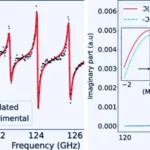The researchers have unveiled a remarkable finding shedding light on the dynamics of galaxy evolution in the early Universe. It is achieved by a groundbreaking collaboration between Hokkaido University, the University of Tsukuba, Waseda University, the National Astronomical Observatory of Japan, and the National Centre for Nuclear Research (NCBJ) Poland.
The research team has uncovered compelling evidence of star formation suppression driven by molecular gas outflows in a quasar-host galaxy. Their findings, published in The Astrophysical Journal, mark the first occurrence of such a phenomenon in the cosmos.
Quasars, powered by supermassive black holes at the centers of massive galaxies, emit intense luminosity, offering invaluable insights into the conditions of the early Universe when it was less than 1 billion years old. Molecular gas, essential for star formation, is the primary fuel within galaxies. However, the ejection of this gas into intergalactic space by molecular outflows can impede star formation, regulating the galaxy’s evolution.
The team’s observations, facilitated by the Atacama Large Millimeter/Submillimeter Array (ALMA) in Chile, focused on the quasar J2054-0005, distinguished by its exceptionally high redshift. By detecting molecular gas outflows from this distant quasar, the researchers provided compelling evidence of their impact on galaxy evolution at an early cosmic age.
Assistant Professor Dragan Salak elucidated the method, stating that the outflowing molecular gas was detected in absorption, revealing its presence by observing the “shadow” it cast before the quasar’s radiation. This groundbreaking approach unveiled the potent influence of quasars in suppressing star formation within their host galaxies.
The significance of these findings lies in their implications for our understanding of galaxy formation and evolution. Molecular gas outflows driven by quasars represent a pivotal mechanism shaping the cosmic landscape in the early Universe, with far-reaching consequences for star formation and galaxy dynamics.
Dr. Salak emphasized the crucial role of molecular gas in galaxy evolution, underscoring how quasars can stifle star formation by expelling this vital constituent into intergalactic space.
This breakthrough expands our knowledge of galaxy evolution and underscores the pivotal role of advanced telescopic technologies like ALMA in unraveling the mysteries of the cosmos. As humanity delves deeper into the cosmic tapestry, collaborations like this promise to unveil even more profound insights into the Universe’s intricate workings.










